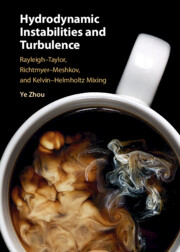 Hydrodynamic Instabilities and Turbulence
Hydrodynamic Instabilities and Turbulence from Part 2 - Hydrodynamics of Complex Flows
A more complex initial setup could be constructed for experimental or numerical studies. Many distinct initial interfacial perturbations may be set up: the standard and inverted chevron shapes, enlarged double-bump, V, W, and sawtooth. The so-called "inclined shock tube" method of perturbing the fluid interface is created by inclining the shock tube with respect to the gravitational field. Tilted tank experiments consist of a tank filled with light fluid above heavy, which is then tilted onto one side of the apparatus. These experiments provide two-dimensional data for mix model development.
To save this book to your Kindle, first ensure [email protected] is added to your Approved Personal Document E-mail List under your Personal Document Settings on the Manage Your Content and Devices page of your Amazon account. Then enter the ‘name’ part of your Kindle email address below. Find out more about saving to your Kindle.
Note you can select to save to either the @free.kindle.com or @kindle.com variations. ‘@free.kindle.com’ emails are free but can only be saved to your device when it is connected to wi-fi. ‘@kindle.com’ emails can be delivered even when you are not connected to wi-fi, but note that service fees apply.
Find out more about the Kindle Personal Document Service.
To save content items to your account, please confirm that you agree to abide by our usage policies. If this is the first time you use this feature, you will be asked to authorise Cambridge Core to connect with your account. Find out more about saving content to Dropbox.
To save content items to your account, please confirm that you agree to abide by our usage policies. If this is the first time you use this feature, you will be asked to authorise Cambridge Core to connect with your account. Find out more about saving content to Google Drive.